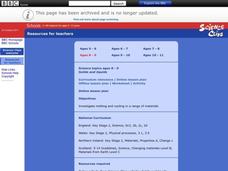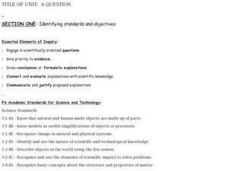Curated OER
What's the Matter?
First graders identify solids, liquids, and gases. For this matter lesson, the teacher guides students through numerous demonstrations as they determine the properties of solids, liquids, and gases and classify things as each. As the...
Curated OER
Matter
In this matter worksheet, students are given 10 sentences with italicized terms that are wrong. Students correct the terms to appropriately fit the sentences. Topics are related to matter such as physical and chemical properties, solids,...
Curated OER
Phase Diagram Worksheet
In this chemical phases diagram instructional activity, students use a diagram to answer 6 questions about the three different phases-solids, liquids and gases. The diagram is of a mystery compound referred to as "X".
Curated OER
Solids and Liquids
Learners investigate what happens to solids and liquids when they change from one form to another. In this states of matter activity, students work in groups on a virtual experiment that requires them to collect data regarding the...
Curated OER
States of Matter
In this states of matter activity, students read a 2 page article on the 5 states of matter, answer statements with multiple choice answers, fill in 4 fill in the blank statements and 3 true or false statements about the 5 states of matter.
Curated OER
Science--"Water, Water Everywhere"--Exploring Liquids
In this water worksheet, students read a 1 page article on water, fill in the blanks of 3 words with their missing letters, fill in a crossword puzzle containing 5 clues about water and answer 1 short answer question. Students draw a...
Curated OER
How Can You Group Matter?
In this matter worksheet, students will categorize and classify different types of matter as either a solid, liquid, or gas. This worksheet is a graphic organizer.
Curated OER
Measuring Liquid Volume & Reading Thermometers
In this liquid volume worksheet, students first practice measuring liquid volume by determining what volume is indicated on each of the graduated cylinders in milliliters for the first nine problems. Then they determine the temperature...
Curated OER
Brain POP - States of Matter
In this states of matter worksheet, students visit the website http://www.brainpop.com/science/matter and watch a movie to complete 7 fill in the blank questions, 5 matching questions, and an 18 clue crossword.
Curated OER
The States of Matter
Students apply an inquiry based approach to classic experiments to foster their knowledge and appreciation for the properities of matter. At the conclusion of the instructional activity, they gain knowledge about the properities of...
Curated OER
Oobleck
First graders explore Oobleck. They manipulate and observe the properties of Oobleck. Students discuss the differences between solids and liquids. They investigate Oobleck. Students write a sentence describing what they observed about...
Curated OER
Liquids in Bottles
Students investigate different liquids to develop their concept of a liquid. They work at a center to tip, swirl, shake, roll, and otherwise investigate seven liquids in small, clear plastic bottles: plain water, corn syrup, liquid...
Curated OER
Solid, Liquid, Gas!
Students determine the properties of the solids, liquids, and gases, and how they can recognize those properties by observing a teacher demonstration. Next, they experiment with at mystery matter that looks like a liquid but that takes...
Curated OER
Density of Liquids
Young scholars apply knowledge about density of solids from previous experimentation to this activity which they investigate the density of liquids. They work in small groups to mix water and syrup, and water and oil to see what occurs....
Curated OER
Strange States of Matter
Fourth graders explore objects that do not fit into the categories given by three states of matter. They explore why an object doesn't fit perfectly into one of the three categories. Students observe the properties of Oobleck. They...
Curated OER
Liquids Have Differnt Viscosities
Students explore visosity of matter. They run tests of various liquid substances to observe and compare rates of flow of different substances. In addition, they relate viscosity to distance travelled by sample substances.
Curated OER
Density of Solids and Liquids
Students calculate the density of regular and irregular solids and liquids. They relate the term dense to science as well as its literal meaning that society uses it as everyday. A worksheet is completed on density.
Curated OER
A QUESTION
Students engage in scientifically oriented questions. They give priority to evidence, draw conclusions/formulate explanations and connect/evaluate explanations with scientific knowledge. Students communicate and justify proposed...
Curated OER
Matter
First graders study and define matter. They observe and identify states of matter along with common attributes and study how matter can change form or change its state depending on temperature.
Curated OER
Causal Patterns in Density Phenomena
Young scholars investigate the relationship between volume and mass in different liquids such as vegetable oil, rubbing alcohol and water. They measure the mass of several different volumes of each liquid and then graph the results as...
Curated OER
Solids/Liquids - Inquiry Lesson
First graders explore the characteristics of solids and liquids. In groups, they generate ideas on how a solid is transformed to a liquid and back to a solid. They make predictions on how the process can be speeded up with a partner. ...
Curated OER
Making Ice Cream
Student examine the physical changes of matter and are able to describe them. They make ice cream in plastic bags to observe the changes in matter. They describe and record the changes in the ice cream mixture as it freezes.
Curated OER
It's a Matter of Change
Learners watch a video on matter and identify examples of solids, liquids and gases in the classroom. They discuss the attributes for each kind of matter and conduct an experiment to explore how matter can change form.
Curated OER
The Three States of Matter: Energy Matters
Students examine the states of matter; solids, liquids and gases. They explain how the states of matter change from one to another.

























